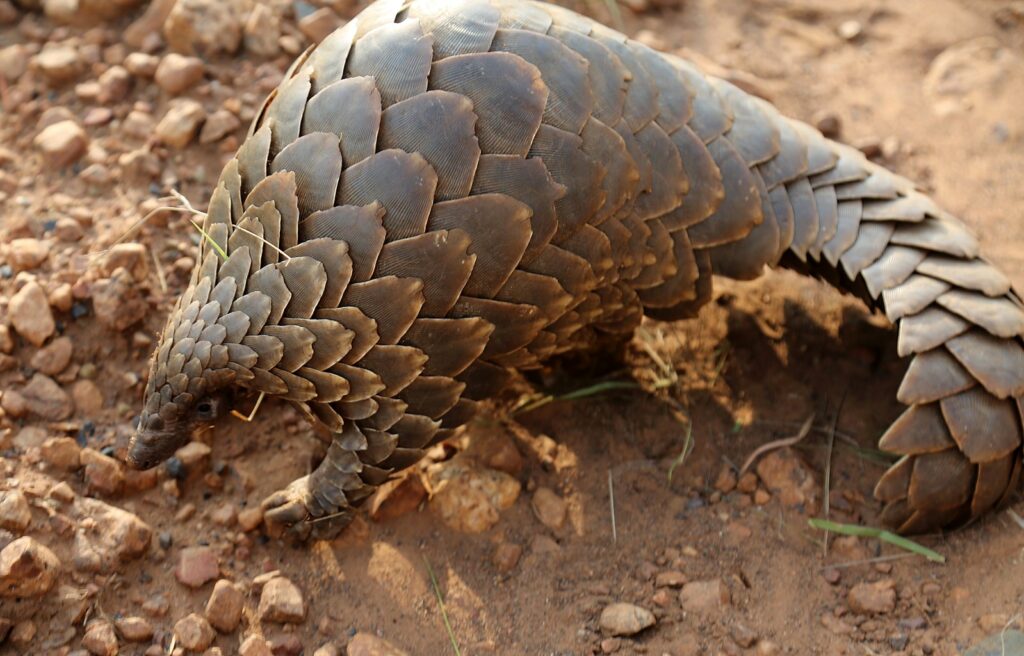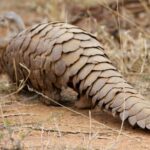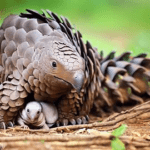
Image: Pangolin Wikimedia CommonsCC By 2.0
Pangolins have caused quite a stir recently. So, do they pose any threat to humans or other animals?
Pangolins belong to the Pholidota order. They have scales made of keratin – the same material as human hair and nails. They usually curl up into a ball when scared, so they’re not typically aggressive.
Pangolins have a special diet. They only eat ants and termites, slurping them up quickly with their long tongues. Some insects can sting or release toxins as defense, but pangolins are protected by thick skin and strong stomach muscles.
Plus, they help keep insect populations under control. This makes them important to the environment.
Unfortunately, pangolins are the most trafficked mammal in the world. People hunt them for their meat and scales, which are used in traditional medicine. Despite international laws, illegal trade persists and pangolin numbers keep declining.
Key Takeaways
- Pangolins are not inherently dangerous to humans. They are shy and non-aggressive creatures that prefer to avoid human contact.
- Despite their harmless nature, pangolins are currently the most trafficked mammal in the world due to the high demand for their scales and meat.
- Pangolins are known carriers of zoonotic diseases, including coronaviruses. However, it is important to note that the transmission of diseases from pangolins to humans is rare and requires close contact.
- The illegal trade and consumption of pangolins pose a significant threat to their survival as a species. Conservation efforts are crucial to protect these unique creatures from extinction.
- Raising awareness about the importance of pangolins in ecosystems and the need to combat illegal wildlife trade is essential for their long-term survival.
Overview of Pangolins
Pangolins are captivating creatures with their scaly armor and mysterious nature. Let’s delve into some interesting facts about these unique mammals.
They boast an amazing adaptation to their surroundings, with overlapping scales for protection. Pangolins inhabit diverse environments, ranging from tropical forests to savannahs. They mainly eat ants and termites, using their long, sticky tongue to capture prey.
These solitary mammals show intriguing behaviors, from rolling into a protective ball to vocalizing. Plus, they have specialized scales made of keratin, and keen senses of smell and hearing.
With increasing threats such as habitat loss and illegal poaching, it’s essential to protect them from extinction. We can spread awareness and support conservation efforts, for the sake of our planet’s biodiversity and the future of Pangolins. So embrace the opportunity to be part of their preservation!
Myths and Misconceptions about Pangolins
Pangolins are often misunderstood. Let’s clear the myths and uncover the truth. They’re not aggressive predators. Their scales resemble ivory, but they’re made of keratin. It’s illegal to keep pangolins as pets.
Their amazing ability to curl up in a ball is unique. In the past, people thought unicorns were imaginary, until explorers found pangolins. But now, sadly, pangolins have become a hot commodity on the black market.
The Real Threats to Pangolins
Pangolins are in danger! Habitat loss, illegal hunting, and the illegal wildlife trade are all contributing to their decline.
Forests are being cleared for urban development and agriculture, leaving limited space for pangolins to live and eat ants and termites.
Hunting is another issue, as pangolins are killed for their meat and scales. The demand for these products leads to a flourishing black market trade, which makes it difficult to protect them.
Electrocution from power lines is a lesser-known threat, as pangolins can’t see them and climb trees or utility poles without realizing the danger. Electrocution incidents have been reported, further decreasing their numbers.
It’s important to recognize how human activity has caused a decline in pangolins over millions of years. Conservation efforts are necessary to save these unique creatures.
Conservation Efforts for Pangolins

Conservation efforts for pangolins are vital to protect these endangered species. These efforts target preserving their habitats and fighting illegal hunting and trafficking. Conservationists strive hard to raise awareness, advocate for stronger laws, and promote sustainable practices.
- Raising public awareness: Education initiatives are key to inform people about the significance of pangolins and the threats they face.
- Supporting local communities: Connecting with communities near pangolin habitats helps to endorse sustainable practices and to provide alternative livelihoods.
- Strengthening legislation: Advocacy strives to push for stricter laws regarding poaching, smuggling, and trading of pangolins.
- Collaboration with law enforcement agencies: Conservation organizations team up with authorities to enhance enforcement capabilities and improve wildlife crime investigation.
- Protecting habitats: Conservation specialists recognize important regions that need protection and implement measures to secure these habitats from deforestation or other destructive practices.
- Research and monitoring: Investing in research supports to better understand pangolin behavior, population dynamics, and the effect of conservation efforts.
In addition to these ongoing conservation efforts, joint efforts between governments, NGOs, and global organizations are key to protecting pangolins. By working together towards common objectives, we can provide lasting solutions for the survival of this extraordinary species.
To further safeguard pangolins, the following are suggested:
- Strengthen penalties: Governments should bring in stricter penalties for those involved in pangolin trafficking to deter probable offenders.
- Enhance international cooperation: Promoting collaboration among countries is critical in fighting transnational wildlife crime networks.
- Promote sustainable trade alternatives: Supporting initiatives such as eco-tourism or non-lethal use of pangolins can reduce the demand for their illegal trade.
- Strengthen border controls: Stricter regulations at borders facilitate early detection and interception of pangolin smuggling.
- Engage local communities: Including local communities in conservation efforts can empower them to protect pangolins and their habitats.
Executing these suggestions will add to the ongoing conservation efforts, guaranteeing a brighter future for pangolins and the preservation of our abundant biodiversity. Pangolins may have a reputation for being dangerous, but let’s be real, they’re more likely to give you a paper cut than anything else.
Frequently Asked Questions
Q: Are pangolins dangerous?
A: Pangolins are not inherently dangerous to humans. In fact, they are shy and non-aggressive animals that usually try to avoid confrontations.
Q: Can pangolins harm humans?
A: While pangolins have sharp claws, they are mainly used for digging into ant and termite mounds to find food. It is rare for them to use these claws to harm humans.
Q: Are pangolins venomous?
A: No, pangolins are not venomous. They rely on their scales and defensive behaviors, such as rolling into a ball, to protect themselves from predators.
Q: Can pangolins transmit diseases to humans?
A: Pangolins have been linked to the transmission of certain diseases, including coronaviruses. It is important to handle them with care and avoid direct contact to minimize any potential health risks.
Q: Are pangolins aggressive towards humans?
A: No, pangolins are generally not aggressive towards humans. They are more likely to curl up into a defensive ball or attempt to flee when they feel threatened.
Q: Are pangolins protected by law?
A: Yes, many countries have laws protecting pangolins due to their endangered status. Illegal poaching and trafficking of pangolins and their products are major threats to their survival.
Conclusion
Pangolins are not dangerous to humans. They are gentle, and their diet is mostly insects.
Recently, they have gained attention due to their potential role in zoonotic diseases. But, they can only harbor pathogens, and not cause them.
In fact, pangolins are beneficial. They eat ants and termites, helping to control insect populations. We should understand their importance, rather than viewing them as a threat.
Sadly, pangolins have been targeted for their scales and meat. This has caused illegal wildlife trade and poaching. This shows us our responsibility to protect biodiversity and keep harmony with nature.
References




